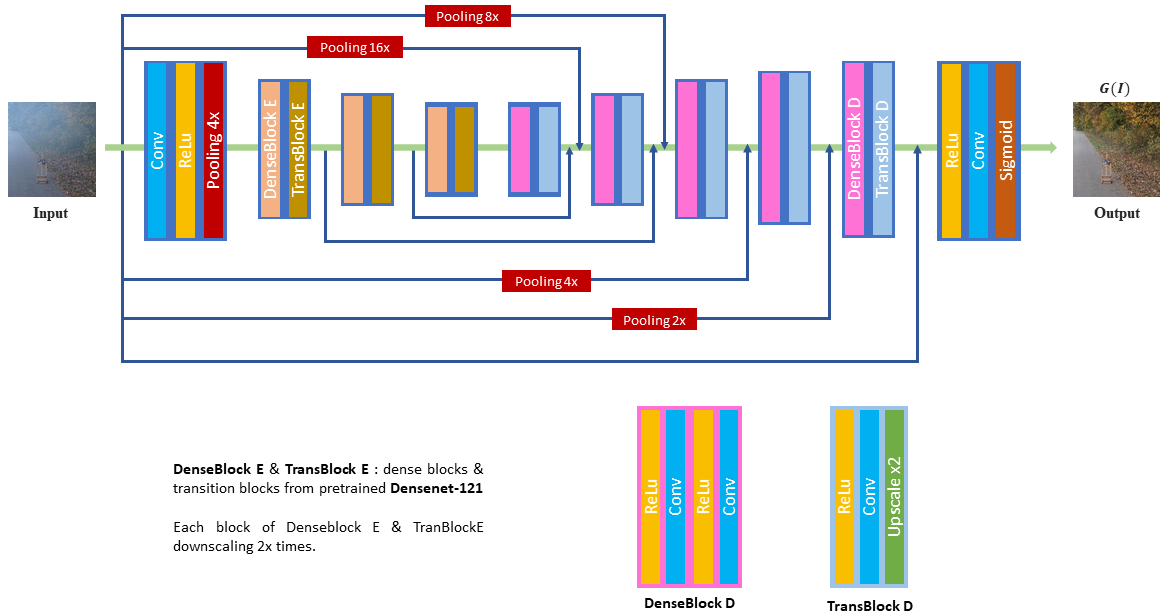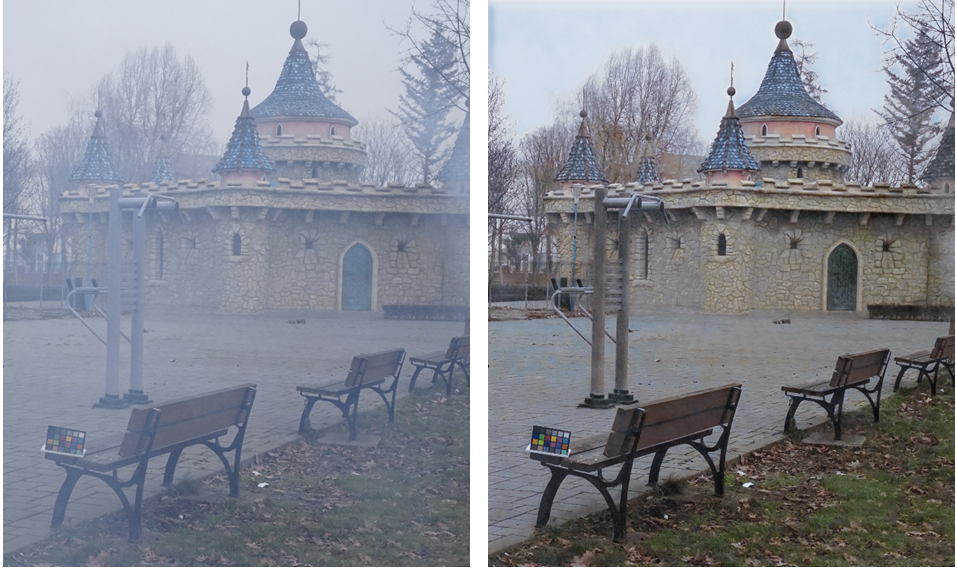This project is to implement a GAN-based method for Image Dehazing
Figure 1. Generator. The generator can directly output the haze-free images without estimation of intermediate parameters.
Figure 2. Discriminator. The discriminator can guide the generator to generate more realistic dehazed results.
To run this project you need to setup the environment, download the dataset, and then you can train and test the network models. I will show you step by step to run this project and I hope it is clear enough.
The project is tested on Ubuntu 16.04, GPU Titan V. Note that one GPU is required to run the code. Otherwise, you have to modify code a little bit for using CPU. If using CPU for training, it may too slow. So I recommend you using GPU strong enough and about 12G RAM.
Python 3.5 or 3.6 are recommended.
tqdm==4.19.9
numpy==1.17.3
tensorflow==1.12.0
tensorboardX
torch==1.0.0
Pillow==6.2.0
torchvision==0.2.2
I recommend using virtualenv for making an environment. Run the following commands in the root folder.
virtualenv -p python3 .env
source .env/bin/activate
pip install -r requirements.txt
I use NTIRE 2018 datasets including I-HAZE (Download) and O-HAZE (Download).
| Training Images | Testing Images | |
|---|---|---|
| I-HAZE | 25 (from 01 to 25) | 5 (from 31 to 25) |
| O-HAZE | 35 (from 01 to 35) | 5 (from 41 to 45) |
After downloading dataset successfully, you need to put images in right folders.
By default:
- dataset/indoor/hazy: includes 25 hazy images from 01 to 25 in I-HAZE dataset
- dataset/indoor/GT: includes 25 ground-truth images from 01 to 25 in I-HAZE dataset
- dataset/outdoor/hazy: includes 35 hazy images from 01 to 35 in O-HAZE dataset
- dataset/outdoor/GT: includes 35 ground-truth images from 01 to 35 in O-HAZE dataset
I recommend you using ln -s command to prepare data. If you are new at that command, check out this tutorial.
I provide pretrained models (here). Downloading the zip file and extracting to trained_model folder. You can generate de-hazy images by running the following commands.
For one input images:
python demo.py --model trained_model/indoor.pt --images inputs/31.png --gpu 0
python demo.py --model trained_model/outdoor.pt --images inputs/41.png --gpu 0
For multiple input images:
python demo.py --model trained_model/indoor.pt --images inputs/31.png inputs/32.png inputs/33.png inputs/34.png inputs/35.png --gpu 0
python demo.py --model trained_model/outdoor.pt --images inputs/41.png inputs/42.png inputs/43.png inputs/44.png inputs/45.png --gpu 0
Some dehazed-images generated by my model. Left image: hazy image. Right image: dehazed image.
Training a model on I-HAZE dataset
python main.py --data_dir dataset/indoor --exp indoor --gpu 0
Training a model on O-HAZE dataset
python main.py --data_dir dataset/outdoor --exp outdoor --gpu 0
I evaluate my models by NIQE score. The NIQE source code is available at here.
| Hazy Images | Without GAN | With GAN | |
|---|---|---|---|
| Indoor | 6.4564 | 6.7746 | 4.9167 |
| Outdoor | 4.1471 | 4.4204 | 2.6605 |
- Densely Connected Pyramid Dehazing Network (CVPR'2018)
- FD-GAN: Generative adversarial Networks with Fusion-discriminator for Single Image Dehazing(AAAI'20)
- Multi-scale Single Image Dehazing using Perceptual Pyramid Deep Network (NTIRE-2018-Dehazing-Challenge)
I hope my instructions are clear enough for you. If you find this repo useful, please give me a star. Many thanks!



